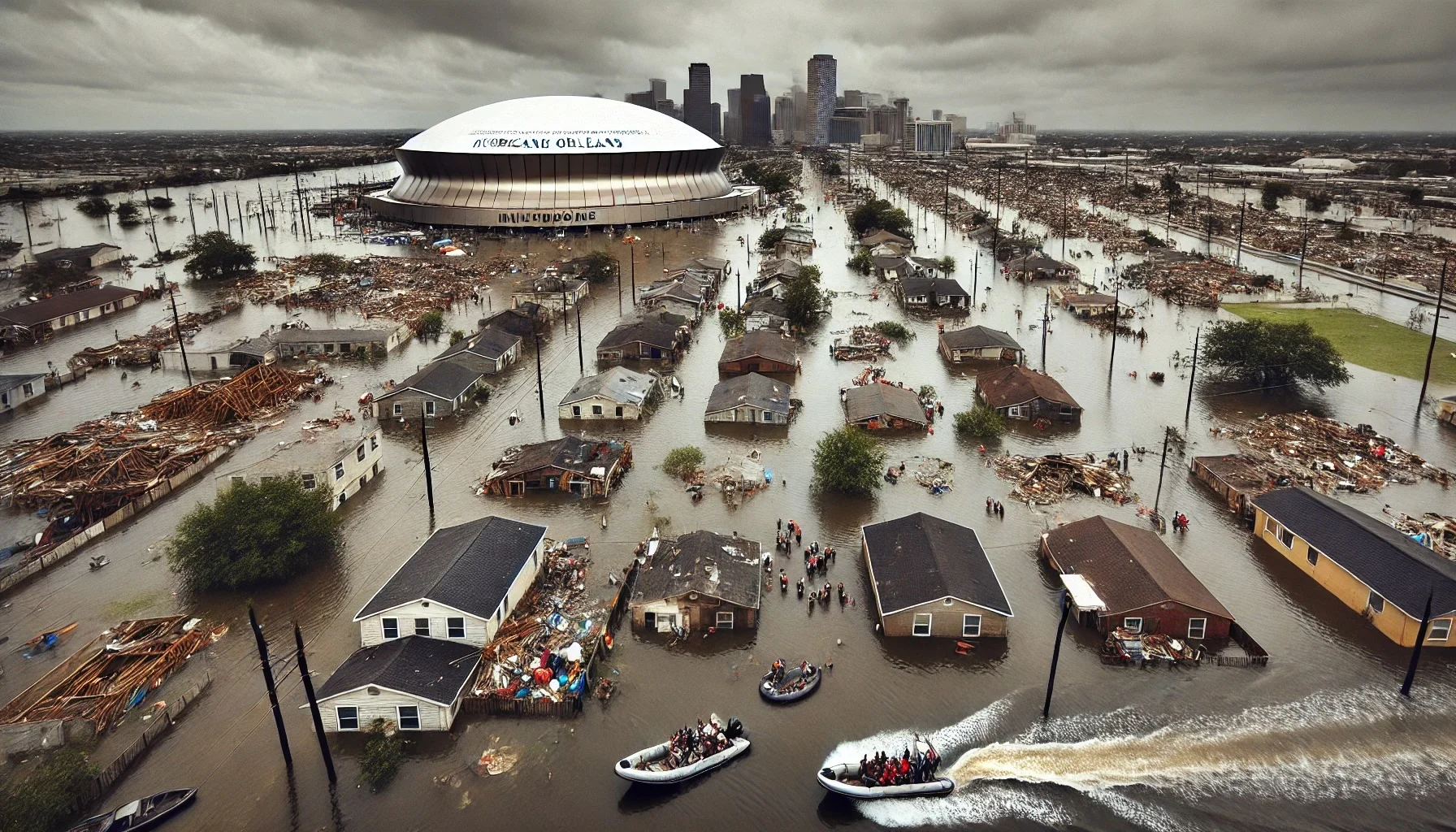
2005 Hurricane Katrina
by: The Calamity Calendar Team
August 29, 2005
In the early hours of August 29, 2005, the Gulf Coast of the United States braced itself for a storm that would change the region forever. Hurricane Katrina, having already demonstrated its destructive potential in Florida, was about to make its most devastating landfall near Buras, Louisiana.
The Birth of a Monster
August 23, 2005: It began innocuously enough—a tropical depression formed over the warm waters of the southeastern Bahamas. By the following day, it had gained enough strength to be named Tropical Storm Katrina. As the storm advanced westward, it rapidly intensified, reaching hurricane status just before striking Miami, Florida, on August 25. Flooding and power outages plagued the region, a mere prelude to the destruction that lay ahead.
August 26-27, 2005: After crossing Florida, Katrina entered the Gulf of Mexico, where it encountered ideal conditions for strengthening—warm sea surface temperatures and low wind shear. In just a day, it exploded into a Category 5 hurricane, with wind speeds soaring to 175 mph and the central pressure dropping to 902 mbar, making it one of the most intense Atlantic hurricanes on record.
The Calm Before the Storm
August 28, 2005: As Katrina churned towards the Gulf Coast, mandatory evacuations were ordered in Louisiana, Mississippi, and Alabama. The National Weather Service issued dire warnings of “devastating” damage. Despite the looming threat, many residents chose to stay, either unable or unwilling to leave their homes.
Thanks for subscribing!
Landfall and Catastrophe
August 29, 2005: Katrina made its second landfall near Buras, Louisiana, as a Category 3 hurricane. Though it had weakened slightly, the storm’s power was far from diminished. With sustained winds of 125 mph, it unleashed a catastrophic storm surge that breached the levees protecting New Orleans. Within hours, 80% of the city was underwater. Homes, businesses, and lives were swept away in an instant.
A City in Crisis
August 30, 2005: The situation in New Orleans deteriorated rapidly. The levee breaches continued to flood the city, trapping residents in attics and on rooftops. Emergency response was slow, hindered by the sheer scale of the disaster and the breakdown of communication and infrastructure. The Superdome and Convention Center, designated as shelters, became scenes of desperation as supplies ran out and conditions worsened.
August 31, 2005: As federal and state response efforts ramped up, National Guard troops arrived in New Orleans to assist with rescue operations. However, the chaos and lack of coordination impeded their effectiveness. Stories of heroism emerged as ordinary citizens and first responders risked their lives to save others, but the overall response was marred by delays and mismanagement.
The Aftermath and Response
September 1-2, 2005: Federal assistance began to arrive, but it was too little, too late for many. The death toll climbed as stranded residents succumbed to the elements and lack of medical care. President George W. Bush’s visit to the devastated areas on September 3 did little to quell the mounting criticism of the government’s handling of the disaster.
September 4-6, 2005: Evacuations continued, and relief supplies slowly began to reach the hardest-hit areas. As floodwaters receded, the full extent of the destruction became apparent. Entire neighborhoods were obliterated, and the lives of millions were disrupted. The economic impact was staggering, with damages estimated at over $125 billion, making Katrina the costliest hurricane in U.S. history.
Learning from Disaster
The response to Hurricane Katrina exposed significant flaws in disaster preparedness and response. The Federal Emergency Management Agency (FEMA) faced harsh criticism for its slow and inefficient response. In the aftermath, the Department of Homeland Security restructured FEMA, and the Post-Katrina Emergency Management Reform Act was enacted to improve federal response capabilities.
Rebuilding and Recovery
Recovery was a long and arduous process. Efforts included rebuilding the levee system to better withstand future storms, revitalizing devastated communities, and providing financial assistance to displaced residents. Programs like the Louisiana Road Home helped homeowners rebuild, but the road to recovery was fraught with challenges.
A Legacy of Change
Hurricane Katrina highlighted the urgent need for better urban planning and resilient infrastructure in the face of climate change. Research suggests that climate change may increase the frequency and intensity of such hurricanes, underscoring the necessity for robust preparedness measures.
The disaster also brought to light the stark social inequities in disaster management. Poorer and minority communities bore the brunt of the devastation, sparking ongoing discussions about social justice and equity in disaster response and recovery.
Conclusion
Hurricane Katrina remains a stark reminder of nature’s fury and the critical importance of preparedness and equity in disaster management. As the Gulf Coast continues to rebuild and adapt, the lessons learned from Katrina guide efforts to protect vulnerable communities from future storms. The story of Katrina is not just one of devastation, but also of resilience, determination, and the enduring human spirit.
Stay in the Loop!
Become a Calamity Insider and get exclusive Calamity Calendar updates delivered straight to your inbox.
Thanks! You're now subscribed.